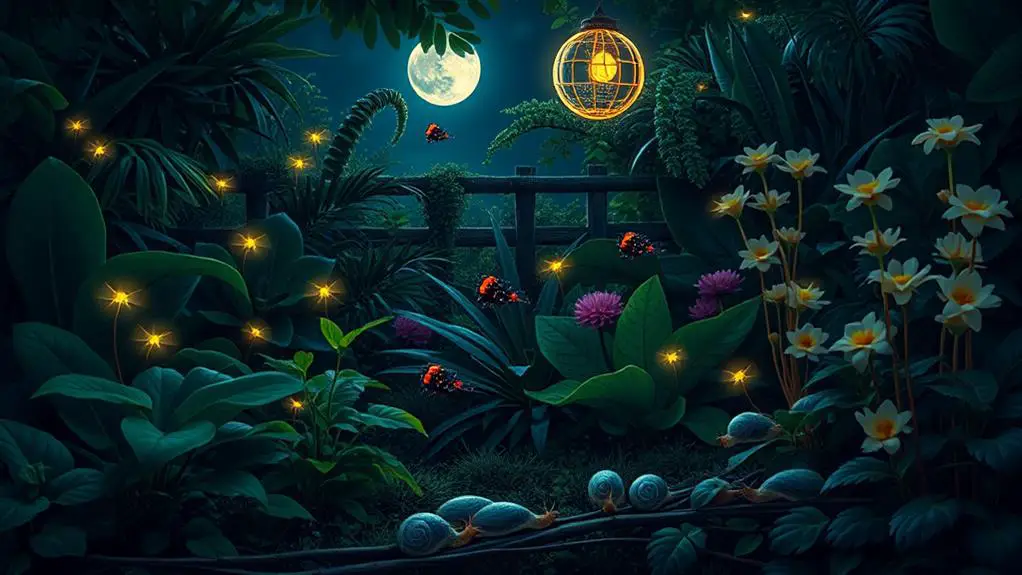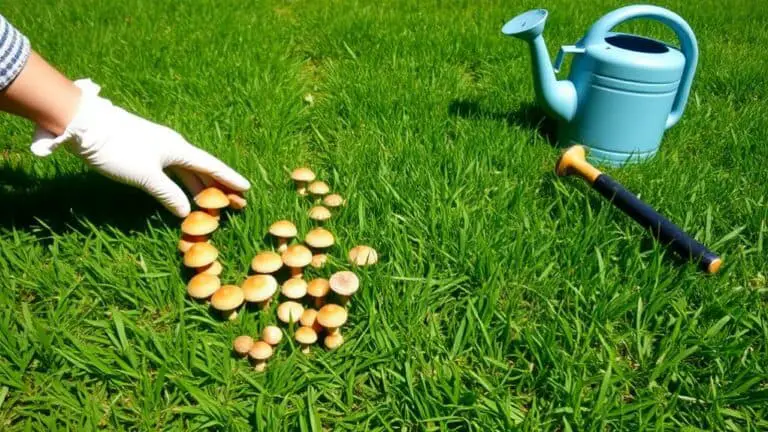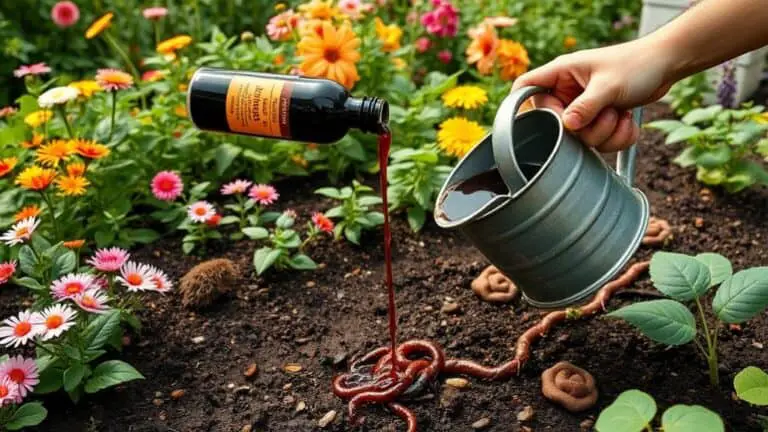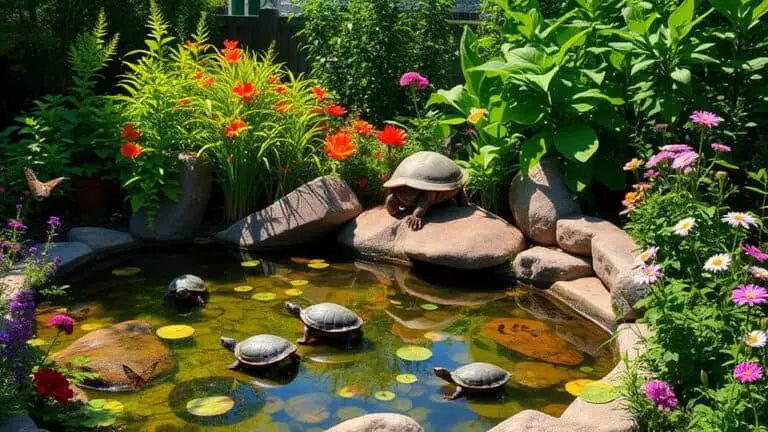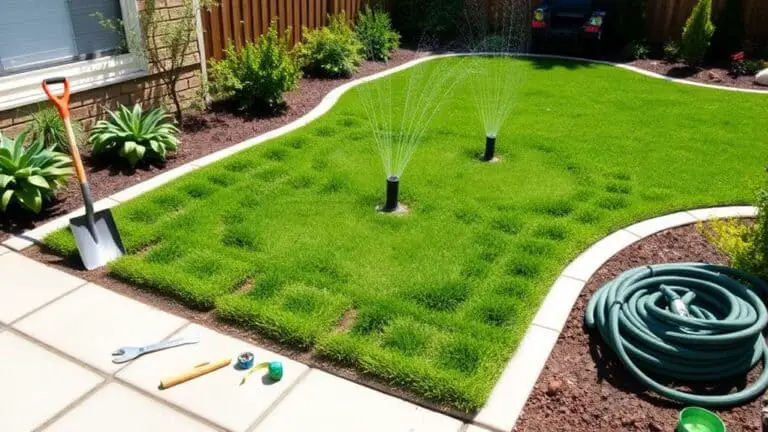Attract Fireflies If You Have A Slug Problem
If you've been battling a slug problem in your garden, you might be interested to know that attracting fireflies could be a natural solution. Firefly larvae are voracious predators of slugs, and creating a habitat for these beneficial insects can help you manage slug populations without resorting to chemicals. By maintaining leaf litter, planting native species, and reducing light pollution, you can create an inviting environment for fireflies. But how exactly does one go about fostering such a habitat, and what other benefits might you gain from it? Let's explore this intriguing approach further.
Benefits of Fireflies

When it comes to dealing with pesky slugs in your garden, fireflies offer a natural and effective solution. Attracting fireflies can help control slug populations because their larvae feast on slugs, snails, and cutworms. This not only keeps your garden healthier but also reduces the need for chemical pesticides.
With around 200 species of fireflies in North America, their diverse presence enhances local biodiversity and ecosystem health. Imagine enjoying their enchanting bioluminescent displays on warm summer nights, knowing they're working hard for your garden.
Creating Suitable Habitats
To create a suitable habitat for fireflies, start by providing moist leaf litter which offers them shelter and breeding grounds.
Planting native vegetation supports a healthy ecosystem that helps both fireflies and slugs thrive.
Provide Moist Leaf Litter
Creating suitable habitats for fireflies starts with providing moist leaf litter in your garden. This leaf litter creates an ideal firefly habitat, especially for larvae that thrive in decaying organic matter.
They feed on slugs, snails, and cutworms, helping control your garden pests. Moist leaf litter also serves as shelter and breeding grounds, allowing fireflies to complete their life cycle safely.
Plus, it retains soil moisture, essential for firefly populations in warmer climates.
- Moist leaf litter supports firefly larvae by providing food and shelter.
- Leaf piles offer safe breeding areas for fireflies.
- Retained soil moisture helps maintain a healthy firefly habitat.
Plant Native Vegetation
Planting native vegetation in your garden is a fantastic way to create a diverse habitat that supports both fireflies and slugs. Native plants attract beneficial insects, contributing to a balanced ecosystem.
Native grasses and wildflowers provide cover and breeding grounds for fireflies, while also offering food sources for slugs, essential for firefly larvae's diet. Moisture-loving native plants near water sources enhance habitat suitability, promoting higher firefly populations that naturally manage slug numbers.
Leaving areas of your garden unmowed with native groundcovers creates ideal conditions for firefly larvae, providing shelter and food sources. Choosing plants that thrive in your local ecoregion guarantees compatibility with firefly populations, creating a thriving environment supporting both fireflies and slugs.
Ensure Dark Environments
A key strategy for attracting fireflies to your garden is ensuring dark environments. Fireflies need darkness to communicate and attract mates. By reducing light pollution, you're helping them find each other more easily during summer nights.
Here are some practical steps:
- Turn off outdoor lights: Limit the use of garden lights or install motion-sensor lights that only activate when needed.
- Use light shields: If you must have lights, use shields to direct the light downward and reduce its spread.
- Plant dense vegetation: This can create naturally darker areas and provide hiding spots from predators.
Maintaining a dark environment not only attracts fireflies but also benefits the whole ecosystem, including controlling slug populations.
Your garden will thrive, and you'll create a magical night-time atmosphere.
Managing Light Pollution
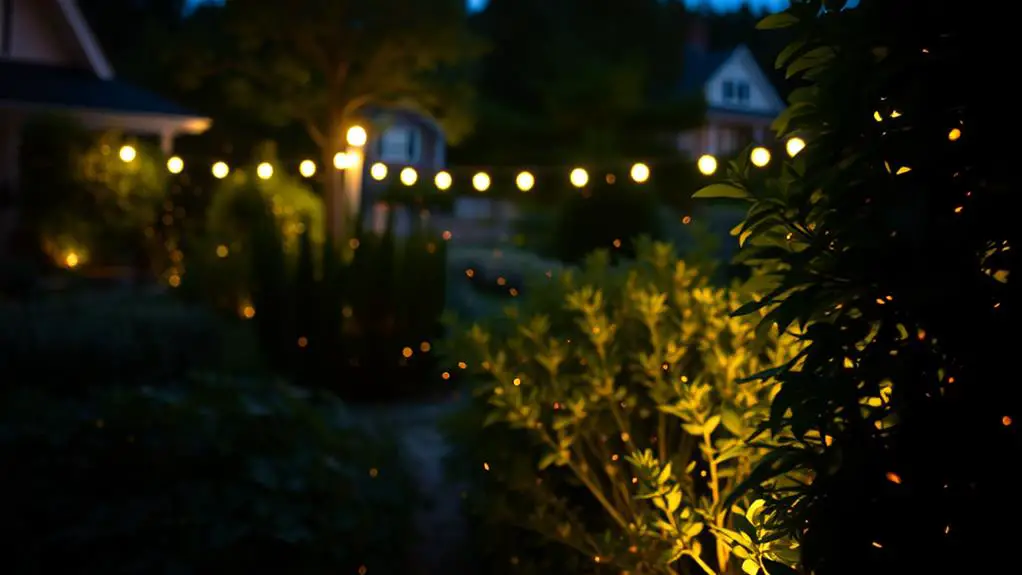
To help fireflies thrive and tackle slug problems in your garden, it's important to manage light pollution.
Reducing outdoor lighting by using dimmer lights, motion sensors, and timers can make a big difference. You can also shield or turn off lights in areas where fireflies are active, creating a darker environment that supports their mating and helps conserve wildlife.
Reduce Outdoor Lighting
Reducing outdoor lighting is essential for allowing fireflies to communicate effectively through their mating signals. When we reduce outdoor lighting, we help fireflies prefer our gardens as their habitat.
Excessive light can disrupt their flashing patterns, making it hard for them to find mates. Not only does dimmer lighting enhance firefly visibility, but it also creates a magical atmosphere in our gardens during summer nights.
Here are some steps we can take:
- Dim or shield outdoor lights to reduce glare and light pollution.
- Use low-intensity bulbs that emit a warm glow rather than harsh, bright light.
- Turn off unnecessary lights after dark to give fireflies a better chance to thrive.
Use Motion Sensors
While dimming or shielding outdoor lights helps create a welcoming environment for fireflies, another effective strategy involves using motion sensors for outdoor lighting. Motion sensors minimize light pollution, letting fireflies' natural glow shine. They also conserve energy by turning off lights when no one is present, promoting a darker, firefly-friendly environment. Installing motion-activated lights reduces overall brightness during peak firefly times, enhancing their visibility. This approach supports healthier firefly populations by reducing artificial light interference. Plus, it makes your garden more enchanting at night.
Here's a quick overview:
| Benefit | Description | Effect on Fireflies |
|---|---|---|
| Minimize Light Pollution | Less constant light | Enhances bioluminescence |
| Conserve Energy | Lights off when not needed | Supports darker environments |
| Promote Healthier Populations | Reduced artificial light during mating season | Healthier firefly populations |
Implement Light Shields
Light pollution disrupts firefly mating signals and behaviors, making it essential to implement light shields in your garden.
By reducing unnecessary light, you can effectively attract fireflies and create a better environment for them. Here are some practical steps:
- Use motion sensors and timers: These help minimize light pollution by only illuminating areas when needed.
- Install proper light shields: Directing light downwards improves visibility for fireflies and limits disruption.
- Dim outdoor lights: This not only enhances the enchanting glow of fireflies but also conserves energy.
Supporting firefly populations through effective light management can indirectly help control slug populations, as fireflies prey on slugs during their larval stage.
Let's create a garden that's friendly to both fireflies and the environment!
Avoiding Pesticides
Why should you consider avoiding pesticides in your garden?
Avoiding pesticides isn't just good for fireflies; it's vital for maintaining a balanced ecosystem.
When you skip the chemicals, you allow beneficial insects like fireflies to thrive.
These little bugs are natural pest controllers, especially for slugs. Their larvae feed on soft-bodied pests, so keeping a pesticide-free environment guarantees they've plenty to eat.
Adding Water Features
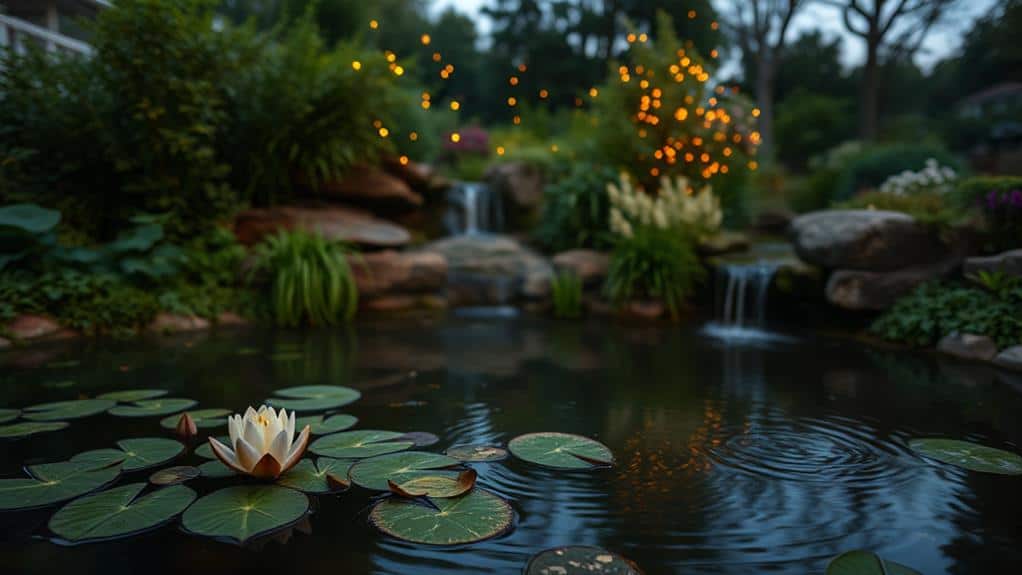
Adding water features to your garden is a great way to attract fireflies while boosting overall biodiversity.
Ponds, birdbaths, and small container ponds create moist environments that fireflies love and need for mating and survival.
Plus, these features help balance the ecosystem, supporting fireflies and their food sources, like slugs.
Benefits of Water Features
Creating a garden oasis with water features like ponds or birdbaths not only enhances aesthetic appeal but also attracts beneficial fireflies.
Fireflies love moist environments, thriving near water edges. By adding water features, you're creating a habitat where fireflies can mate and reproduce, which helps control slug populations.
Here are some benefits of adding water features:
- Moisture Retention: Water features help keep the garden soil moist, creating a favorable microclimate for firefly larvae.
- Attracting Wildlife: Frogs and beneficial insects, which also help control slugs, are drawn to water features.
- Urban-Friendly: Even small container ponds in urban or suburban settings can provide essential habitats for fireflies and other wildlife.
Adding water features is a simple, natural way to enhance your garden and tackle slug problems.
Types of Water Features
Occasionally overlooked, water features can transform your garden into a haven for fireflies and other beneficial creatures.
Adding a small pond or container pond creates a moist environment where fireflies thrive, especially near the edges of standing or running water. Birdbaths also work well, offering a water source for both adult fireflies and their larvae.
If you prefer moving water, consider adding a fountain; the humidity it generates will attract even more wildlife.
Don't forget to place these water features in shady areas. This helps maintain a favorable microclimate and provides resting spots for fireflies.
Growing Native Plants
Growing native plants in your garden is a powerful way to support a diverse ecosystem that attracts fireflies and keeps slug populations in check.
Native plants are adapted to local conditions, ensuring they thrive and create a lush habitat. By integrating a mix of wildflowers, grasses, and shrubs, you can make your garden a haven for fireflies while maintaining a balance with slug populations.
Imagine your garden featuring:
- Milkweed: Supports pollinators like butterflies and fireflies.
- Asters: Flourish in local conditions and attract insects.
- Native grasses: Provide shelter and food for firefly larvae.
Leaving Organic Matter
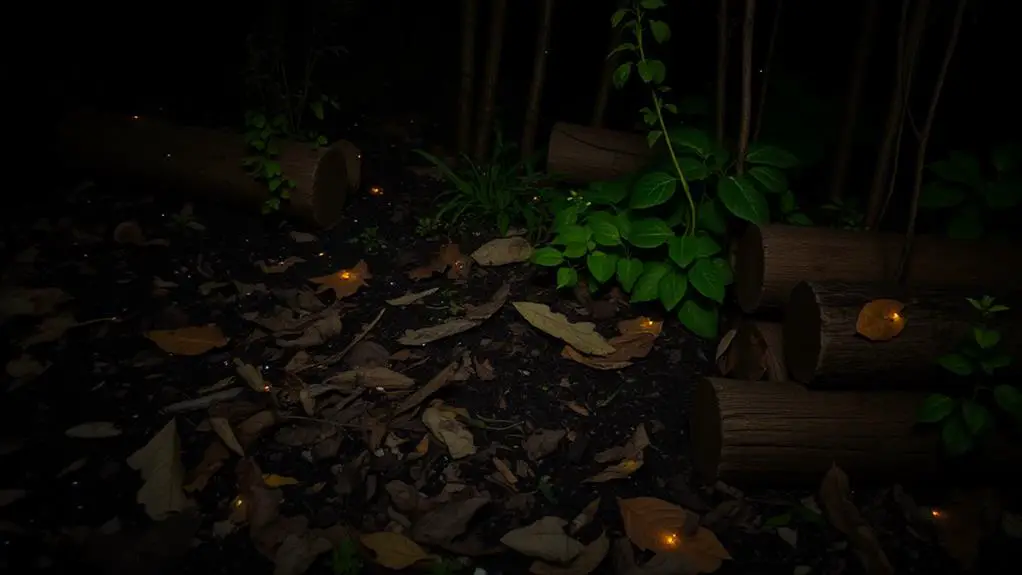
Leaving organic matter like fallen leaves and branches in your garden can work wonders for attracting fireflies while managing slug problems. By allowing these natural materials to stay, you're creating the perfect habitat for firefly eggs and larvae. They thrive in areas rich in organic matter, which means more fireflies lighting up your evenings.
Plus, this organic matter provides shelter and food for slugs, which firefly larvae love to eat. It's a win-win situation!
Beyond just attracting fireflies, leaving organic matter also enhances soil health. A healthier soil fosters a diverse ecosystem, benefiting both fireflies and their food sources.
Building Wood Piles
Building wood piles in your garden can make a huge difference in attracting fireflies.
By creating moist, dark environments, you're providing ideal conditions for firefly eggs and larvae. Plus, these wood piles help maintain slug populations, which are essential for firefly larvae to grow.
Here's how to do it:
- Gather fallen branches: Use what you already have to form brush piles. These provide shelter for adult fireflies.
- Pile organic debris: Add leaves and twigs to maintain humidity levels and create a good breeding ground.
- Strategically place wood piles: Position them around your garden to support a balanced ecosystem for both fireflies and slugs.
Engaging the Community
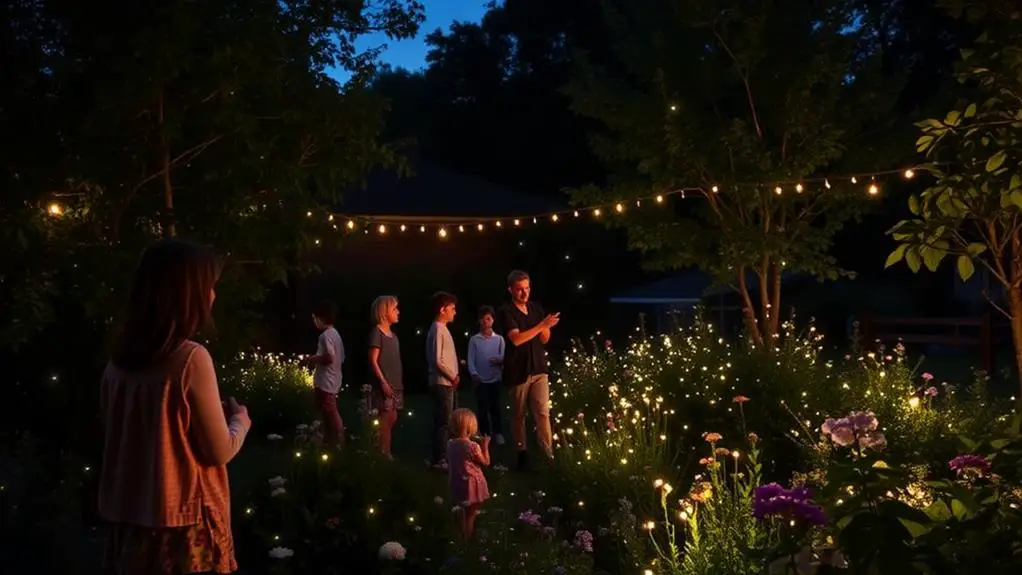
While setting up wood piles in your garden can create a welcoming environment for fireflies, engaging the community amplifies these efforts.
Organize events to plant native flora, attracting both fireflies and their food sources, like slugs. Host educational workshops to inform neighbors about reducing pesticide use, which protects fireflies and promotes a healthier ecosystem.
Participate in community clean-up initiatives to remove debris and litter that disrupt firefly habitats. Advocate for local policies supporting dark sky standards to reduce light pollution, helping fireflies communicate and mate.
Monitoring Firefly Populations
Monitoring firefly populations offers invaluable insights into the health of our local ecosystems.
When we regularly observe fireflies, especially during their peak mating season from late spring to early summer, we can learn a lot about their abundance and behavior. This also helps us spot environmental issues like habitat loss and pesticide use.
Here's what you can do:
- Join citizen science projects to contribute valuable data.
- Record sightings of firefly displays, noting frequency and locations.
- Collaborate with local conservation groups to enhance monitoring efforts.
Frequently Asked Questions
Do Fireflies Eat Slugs?
Yes, firefly larvae eat slugs. In fact, their diet includes various soft-bodied insects, making them effective slug predators. By attracting fireflies, you can naturally control slug populations and reduce the need for chemical pest control.
Is There Anything You Can Do to Attract Fireflies?
You can attract fireflies by creating firefly habitats with leaf litter and organic debris, minimizing outdoor lighting, and planting native grasses. Avoid using chemical pesticides; they're harmful. Instead, use natural repellents to maintain a healthy ecosystem.
Which Would Make a Yard Firefly Friendly?
To make your yard firefly-friendly, I'd plant native plants, maintain high moisture levels with a small pond, avoid chemical pesticides, and keep some tall grass and leaf litter for their habitat. It's simple and effective!
Are Fireflies Good to Have Around?
Absolutely, fireflies are great to have around! They provide numerous firefly benefits, like natural pest control and pollination. Plus, they enhance the garden ecosystem, making it healthier and more vibrant. Their magical glow also beautifies the space.
Conclusion
By attracting fireflies to your garden, you're not just adding a magical touch of light; you're also tackling slug problems naturally. Remember to create suitable habitats, manage light pollution, and avoid pesticides. Adding water features and organic matter, along with building wood piles, can make your garden a welcoming home for fireflies. Engage your community and keep an eye on firefly populations. With these simple steps, you'll have a healthier, more balanced garden in no time!

